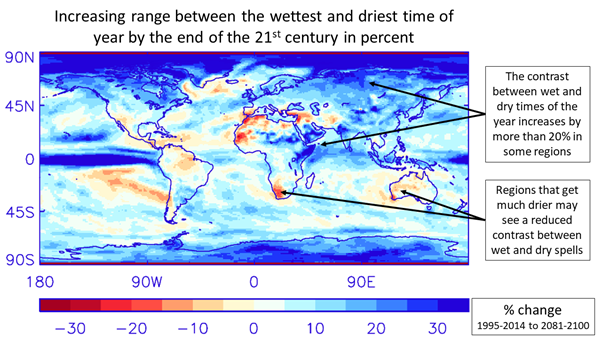
News and media

More severe wet and dry extremes as rapid warming of climate continues

The UK weather has recently been characterised by large swings between wet and dry periods, with heatwave and drought in summer 2022 followed by a series of very wet conditions with localised flooding then very dry periods with water deficits in some regions and heightened wildfire risk (see for example the Centre for Ecology and Hydrology monthly summaries).
Following record heat in June 2023, the weather has appeared stuck, funnelling cool, dreary conditions over the UK, while parts of North America, the Mediterranean and China bake, burn or flood with record global average temperatures. And as the climate continues to warm, the extremes of wet and dry become more intense.
In new research published in Environmental Research Letters, satellite and ground-based data are combined with simulations since the 1950s to show that the range between the wettest and driest time of the year is growing as the climate warms. This work looks in detail at the difference between the amount of water arriving at the surface from precipitation such as rain and snow and the amount leaving due to evaporation. This is important in affecting how much water people and plants can use. If there is too much building up, flooding can occur but when there is a lack of rain, the soils can dry and eventually lead to drought conditions.
The new analysis finds that the global water cycle is becoming more intense. Wet times of the year when precipitation is much more than evaporation are becoming even wetter but periods of drying, when evaporation is larger than precipitation, are also becoming more intense. For every degree Celsius of global warming, the difference between precipitation and evaporation in these wettest and driest times of the year is becoming larger by about 3 or 4 percent. This means there is a larger contrast between wet and dry spells. In some regions such as northern North America and northern Eurasia, the contrast between wet and dry is expected to increase more than 20% by the end of this century (see diagram). This is important as it means that ensuring a reliable availability of fresh water becomes an increasing challenge but also because the most damaging wet and dry seasons in a year will become more dangerous. Patterns of future change are also found to resemble present day observed trends, which adds to evidence for a more variable and extreme water cycle as the climate continues to warm.

It may seem strange that we could get more extreme dry and more extreme wet spells as the climate warms, but this is possible because a warmer atmosphere is a thirstier atmosphere – it can more effectively sap the soil of its moisture in one region and dump this extra water as heavy rainfall in storms and monsoons, increasing the contrast in weather between regions and between different times of the year. This increasing contrast can lead to severe consequences, such as more intense flooding during wet periods and more rapidly developing droughts as dry spells take hold.
Rapid swings between drought and severe flooding are known to be particularly difficult for countries to deal with. Recent research published in Advances in Atmospheric Sciences by Professor Emily Black has shown that the frequency of “flash” droughts is projected to more than double in many regions over the 21st century. These types of rapidly developing droughts can damage crops and will likely become more frequent in parts of the world including South America, Europe, and southern Africa.
As our greenhouse gas emissions continue to heat the planet, there will be greater swings between drought and deluge conditions that will become more severe over time. We have already seen severe flooding in Japan, China, South Korea and India in 2023, which have caused deaths, damage and power cuts. It is only with rapid and massive cuts in greenhouse gas emissions that we can limit warming and the increasing severity of wet and dry spells. Understanding and using Earth Observation to track these changes is vital for planning and managing our water resources, as well as improving predictions of how the water cycle will evolve in a warming world.
Latest News and Events





